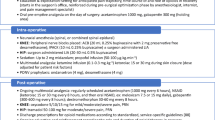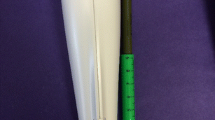Abstract
Purpose of Review
Total knee arthroplasty traditionally has been associated with significant postoperative pain that can limit recovery and prolong hospital length of stay. Recently, however, due to financial pressures and an emphasis on improving patient satisfaction, many institutions are implementing outpatient and short-stay programs for patients undergoing this procedure. An effective perioperative anesthetic plan is an essential quality of a successful outpatient joint replacement program.
Recent Findings
Improved technology and innovation has led to more effective and efficient strategies that contribute to a smoother and quicker postoperative course. The use of peripheral nerve blocks in conjunction with a variety of systemic analgesics has reduced post-operative pain compared to older modalities. Specifically, the adductor canal and IPACK blocks have become increasingly popular due to their analgesic efficacy and muscle sparing characteristics.
Summary
Outpatient knee arthroplasty is becoming a reality with advancements in surgical pathways that incorporate these newer modalities with an emphasis on multidisciplinary coordination.


Similar content being viewed by others
References
Papers of Particular Interest, published recently, have been highlighted as: • Of importance •• Of major importance
Gerbershagen HJ, Aduckathil S, Wijck AJ, Peelen LM, Kalkman CJ, Meissner W. Pain intensity on the first day after surgery: a prospective cohort study comparing 179 surgical procedures. Anesthesiology. 2013;118(4):934–44.
Berger R, Sanders S, Gerlinger T, Della Valle C, Jacobs J, Rosenberg A. Outpatient total knee arthroplasty with a minimally invasive technique. J of Arthroplasty. 2005;20(7):33–8.
• Hanson N, Lee P, Yuan S, Choi D, Allen C, Auyong D. Continuous ambulatory adductor canal catheters for patients undergoing knee arthroplasty surgery. J of Clin Anesth. 2016;35:190–4. Despite being a retrospective case series, this recent publication addresses the feasibility of early discharge of patients following total knee arthroplasty. The study concluded that continuous adductor canal blocks are reasonable options for patients on an outpatient basis, as they can be managed safely and effectively at home after discharge on post-op day 1
Studner O, Chiu MS, Sun X, Mazumdar M, Fleischut P, Poultsides L, Gerner P, et al. Comparative perioperative outcomes associated with neuraxial versus general anesthesia for simultaneous bilateral total knee arthroplasty. Reg Anesth Pain Med. 2012;37:638–44.
Memtsoudis SG, Rasul R, Sazuki S, Poeran J, Danninger T, Wu C, et al. Does the impact of the type of anesthesia on outcomes differ by patient age and comorbidity burden? Reg Anesth Pain Med. 2014a;39(2):112–9. doi:10.1097/AAP.0000000000000055.
Guay J, Choi P, Suresh S, Albert N, Kopp S, Pace NL. Neuraxial blockade for the prevention of postoperative mortality and major morbidity: an overview of Cochrane systematic reviews. Cochrane Database Syst Rev. 2014;1:CD010108. doi:10.1002/14651858.CD010108.pub2.
Memtsoudis SG, Sun X, Chiu Y, Studner O, Liu S, Banerjee S, Mazumdar M, Sharrock N. Perioperative comparative effectiveness of anesthetic technique in orthopedic patients. Anesthesiology. 2013;118(5):1046–58.
Basques B, Toy J, Bohl D, Golinvaux N, Grauer J. General compared with spinal anesthesia for total hip arthroplasty. J Bone Joint Surg Am. 2015;97:455–61.
Zywiel MG, Prabhu A, Perruccio AV, Gandhi R. The influence of anesthesia and pain management on cognitive dysfunction after joint arthroplasty: a systematic review. Clin Orthop Relat Res. 2014;472(5):1453–66.
Choi P, Bhandari M, Scott J, Douketis JD. Epidural analgesia for pain relief following hip or knee replacement. Cochrane Database Syst Rev. 2013;3:CD003071. doi:10.1002/14651858.CD003071.
Pitkanen M, Aromma U, Cozanitis D, Forester J. Serious complications associated with spinal and epidural anesthesia in Finlad from 2000 to 2009. Acta Anesthesiol Scand. 2013;57:553–64. doi:10.1111/aas.12064.
Johnson R, Kopp S, Burkle C, Duncan C, Jacob A, Erwin P, et al. Neuraxial vs general for total hip and total knee arthroplasty: a systematic review of comparative effectiveness research. British Journal of Anesthesia. 2016;116(2):163–76. doi:10.1093/bja/aev455.
Chan EY, Fransen M, Parker DA, Assam PN, Chua N. Femoral nerve blocks for acute postoperative pain after knee replacement surgery. Cochrane Database Syst Rev. 2014;5:CD009941. doi:10.1002/14651858.CD009941.pub2.
Grape S, Kirkham KR, Baeriswyl M, Albrecht E. The analgesic efficacy of sciatic nerve block in addition to femoral nerve block in patients undergoing total knee arthroplasty: a systematic review and meta-analysis. Anaesthesia. 2016; doi:10.1111/anae.13568.
Sharma S, Iorio R, Specht L, Davies-Lepies S, Healy W. Complications of femoral nerve block for total knee arthroplasty. Clin Orthop Relat Res. 2010;468:135–40. doi:10.1007/s11999-009-1025-1.
Ilfeld B, Duke K, Donohue M. The association between lower extremity continuous peripheral nerve blocks and patient falls after knee and hip arthroplasty. Anesth Analg. 2010;111(6):1552–4.
Safa B, Gollish J, Haslam L, McCartney CJ. Comparing the effects of single shot sciatic nerve block versus posterior capsule local anesthetic infiltration on analgesia and functional outcome after total knee arthroplasty: a prospective, randomized, double-blinded, controlled trial. J Arthroplast. 2014;29(6):1149–53. doi:10.1016/j.arth.2013.11.020.
Morin A, Caroline K, Eberhart L, Dinges G, Heider E, Schwarz N. Postoperative analgesia and functional recovery after total knee replacement: comparison of a continuous posterior lumbar plexus (psoas compartment) block, a continuous femoral nerve block, and the combination of continuous femoral and sciatic nerve block. Reg Anesth Pain Med. 2005;30(5):434–45.
Memtsoudis S, Danninger T, Rasul R, Poeran J, Gerner P, Studner O, Mariano E, Mazumdar M. Inpatient falls after total knee arthroplasty: the role of anesthesia type and peripheral nerve blocks. Anesthesiology. 2014b;120:551–63.
Elkassabany NM, Antosh S, Ahmed M, Nelson C, Israelite C, Badiola I, Cai LF, William R, Hughes C, Mariano ER, Lui J. The risk of falls after total knee arthroplasty with the use of a femoral nerve block versus an adductor canal block: a double-blinded randomized controlled study. Anesth Analg. 2016;122(5):1696–703. doi:10.1213/ANE.0000000000001237.
Lund J, Jaeger P, Jenstrup M, Sorensen A, Dahl J. Continuous adductor canal blockade for adjuvant post-operative analgesia after major knee surgery: preliminary results. Acta Anesthesiol Scand. 2011;55:14–9. doi:10.1111/j.1399-6576.2010.02333.x.
Kuang MJ, Xu LY, Ma JX, Wang Y, Zhao J, Lu B, Ma XL. Adductor canal block versus continuous femoral nerve block in primary total knee arthroplasty: a meta-analysis. Int J Surg. 2016;31:17–24. doi:10.1016/j.ijsu.2016.05.036.
Shah N, Jain N. Is continuous adductor canal block better than continuous femoral nerve block after total knee arthroplasty? Effect on ambulation ability, early functional recovery and pain control: a randomized control trial. J Arthroplast. 2014;29(11):2224–9. doi:10.1016/j.arth.2014.06.010.
Jaeger P, Fomsgaard JS, Hilsted KL, Bjerregaard J, Gyrn J, Mathiesen O, Larsen TK, Dahl JB. Adductor canal block versus femoral nerve block for analgesia after total knee arthroplasty: a randomized double blind study. Reg Anesth Pain Med. 2013;38(6):526–32.
Elliot CE, Thobhani S. The adductor canal catheter and interspace between popliteal artery and posterior capsule of the knee for total knee arthroplasty. Regional Anesthesia and Pain Management. 2014;18(4):126–9.
Myers TJ, Elliot CE, Patterson ME, Bland KS, Thomas LC, Soberon JR, Osteen KD, Yuratich DM, Nossaman BD, Scarbrough MC. The adductor canal block combined with IPACK improves physical therapy performance and reduces hospital length of stay. Regional Anesthesia and Pain Medicine 2015 40:5 (197). Abstract presented at the 40th Annual Regional Anesthesiology and Acute Pain Medicine Meeting, May 2015, Las Vegas, NV.
Sinha S, Abrahms J, Sivasenthil A, Freitas D, D’Alessio J, Barnett J, Weller R, Lewis C. Use of ultrasound guided popliteal fossa infiltration to control pain after total knee arthroplasty: A prospective randomized observer blinded study. Regional Anesthesia and Pain Medicine 2012a: 37:6(A51). Abstract presented at the 37th Annual Regional Anesthesiology and Acute Pain Medicine Meeting, March 2012, San Diego, CA.
Sinha SK, Abrahms JH, Arumugam S, D’Alessioo J, Freitas DG, Barnett JT, Weller RS. Femoral nerve block with selective tibial nerve block provides effective analgesia without foot drop after total knee arthroplasty: a prospective, randomized, observe blinded study. Anesth Analg. 2012b;115(1):202–6.
• Sawhney M, Mehdian H, Kashin B, Ip G, Bent M, Choy J, McPherson M, Bowry R. Pain after unilateral total knee arthroplasty: a prospective randomized controlled trial examining the analgesic effectiveness of a combine adductor canal peripheral nerve block with periarticular infiltration versus adductor canal nerve block alone versus periarticular infiltration alone. Anesth Analg. 2016;122(6):2040–6. Published in 2016 this paper is representative of the most recent data we have on adductor canal blocks. It is a high quality prospective randomized control trial that demonstrates the usefulness of the adductor canal block, and compares it to local anesthetic infiltration, which is the method of choice by many surgeons
Elia N, Lysakowski C, Tramer MR. Does multimodal analgesia with acetaminophen, nonsteroidal antiinflammatory drugs, or selective cyclooxygenase-2 inhibitors and patient controlled analgesia morphine offer advantages over morphine alone? Meta-analyses of randomized trials. Anesthesiology. 2005;103(6):1296–304.
Hebl JR, Dilger JA, Byer DE, Kopp SL, Stevens SR, Pagnano MW, Hanssen AD, Horlocker TT. A pre-emptive multimodal pathway featuring peripheral nerve block improves perioperative outcomes after major orthopedic surgery. Reg Anesth Pain Med. 2008;33(6):510–7.
Halawi M, Grant S, Bolognesi M. Multimodal analgesia for total joint arthroplasty. Orthopedics. 2015;38(7):616–25.
Berger R, Kusuma S, Sanders S, Thill E, Sporer S. The feasibility and perioperative complications of outpatient knee arthroplasty. Clin Orthop Relat Res. 2009;467:1443–9. doi:10.1007/s11999-009-0736-7.
Cross M, Berger R. Feasibility and safety of performing outpatient unicompartmental knee arthroplasty. Int Orthop. 2013;38:443–7. doi:10.1007/s00264-013-2214-9.
•• Auyong D, Allen C, Pahang J, Clabeaux J, MacDonald K, Hanson N. Reduced length of hospitalization in primary total knee arthroplasty patients using an updated enhanced recovery after orthopedic surgery (ERAS) pathway. J of Arthroplasty. 2015;30:1705–9. This was chosen as the most relevant and important reference because it is not only very recent (2016), but it also summarizes quite well the most essential factors of a successful outpatient or short-stay total knee arthroplasty program. The article demonstrates that hospital length of stay can be reduced when a well-designed multidisciplinary pathway that incorporates a wide range of analgesic strategies is implemented
Husted H, Lunn TH, Troelsen A, Gaarn-Larsen L, Kristensen BB, Kehlet H. Why still in the hospital after fast-track hip and knee arthroplasty? Acta orethopaedica. 2011;82:679–84.
Author information
Authors and Affiliations
Corresponding author
Ethics declarations
Conflict of Interest
Chris Cullom and Jonathan T. Weed declare that they have no conflicts of interest.
Human and Animal Rights and Informed Consent
This article does not contain any studies with human or animal subjects performed by any of the authors.
Additional information
This article is part of the Topical Collection on Other Pain
Rights and permissions
About this article
Cite this article
Cullom, C., Weed, J.T. Anesthetic and Analgesic Management for Outpatient Knee Arthroplasty. Curr Pain Headache Rep 21, 23 (2017). https://doi.org/10.1007/s11916-017-0623-y
Published:
DOI: https://doi.org/10.1007/s11916-017-0623-y




